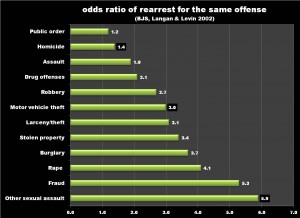CNN’s Anderson Cooper has devoted several recent crime and punishment reports to the pardons meted out by former Mississippi governor Haley Barbour. In several segments, Mr. Cooper seemed incredulous that convicted murderers were allowed to serve as “trustees” in the governor’s mansion prior to their release. In one report, for example, he and attorney Jeffrey Toobin dismissed Governor Barbour’s claim that murderers convicted of a single crime of passion were somehow better suited for such positions than inmates serving time for lesser offenses.
I will not comment here on the uses and abuses of the trustee (or “trusty”) system, except to note that the practice was once widespread but waned considerably after the prisoners’ rights revolution that began in the 1960s. Instead, I’m here to explain why Governor Barbour and his staff preferred employing convicted murderers rather than, say, convicted car thieves.
The chart below is taken from an excellent large-scale Bureau of Justice Statistics recidivism study (Langan and Levin 2002). Overall, 67.5 percent of prisoners were rearrested within 3 years of their release and 25.4 percent were returned to prison for committing new offenses (others were returned to prison for violating the terms of their release). If you click on the chart, you can see that people convicted of homicide have the lowest rate of recidivism as measured by rearrest — 40.7 percent — and the second lowest rate of return to prison for a new offense (10.8 percent). At the other end of the chart, about 79% of those convicted of motor vehicle theft were rearrested and about 31 percent were returned to prison after being convicted of a new crime.
 This doesn’t mean that a 20-year-old murderer is less dangerous than a 20-year-old car thief, of course. It just means that by the time we see fit to release people convicted of homicide, they are unlikely to pose a significant threat to public safety. Many have spent decades in prison and are much older than other inmates when they are finally freed. Convicted murderers make good candidates for pardons precisely because their sentences are soooo long relative to the risk that many of them pose at the tail-end of those sentences.
This doesn’t mean that a 20-year-old murderer is less dangerous than a 20-year-old car thief, of course. It just means that by the time we see fit to release people convicted of homicide, they are unlikely to pose a significant threat to public safety. Many have spent decades in prison and are much older than other inmates when they are finally freed. Convicted murderers make good candidates for pardons precisely because their sentences are soooo long relative to the risk that many of them pose at the tail-end of those sentences.
But aren’t those convicted of killing especially likely to kill again? I mean, a 10.8 percent recidivism rate would be awful if half of those offenses turned out to be new murders. Contrary to all we’ve learned from Quentin Tarantino movies, however, homicide offenders tend not to specialize in killing.
The chart below uses odds ratios to represent the degree of specialization among people convicted of various crimes. Here, the 1.4 for homicide is the ratio of the odds that a homicide offender will be rearrested for another homicide (that’s the numerator in the ratio) relative to the odds that prisoners released for other offenses will be arrested for a homicide (that’s the denominator). You can see some evidence of specialization among those convicted of motor vehicle theft, where the odds of rearrest for a new auto theft are about 1.9 times greater than those for non-car thieves (2.9-1=1.9). There is an even greater degree of specialization for rape and other sexual offenses, with odds ratios of 4.2 and 5.9, respectively, corresponding to rates of new sex offenses that are 3-to-5 times higher than those for people convicted of non-sex crimes. For homicide, however, the odds ratio of 1.4 suggests comparatively little specialization. 
I might also add that a great proportion of homicides are “cleared” by arrest, relative to the other offenses on the list, so it doesn’t seem likely that rampant homicide recidivism is somehow going undetected by the system.
In short, there is much evidence that recidivism rates for people convicted of homicide tend to be particularly low. While it may be politically unpopular to pardon convicted murderers or to place them in positions of trust, they tend to do well when, at long last, they are afforded such opportunities.

